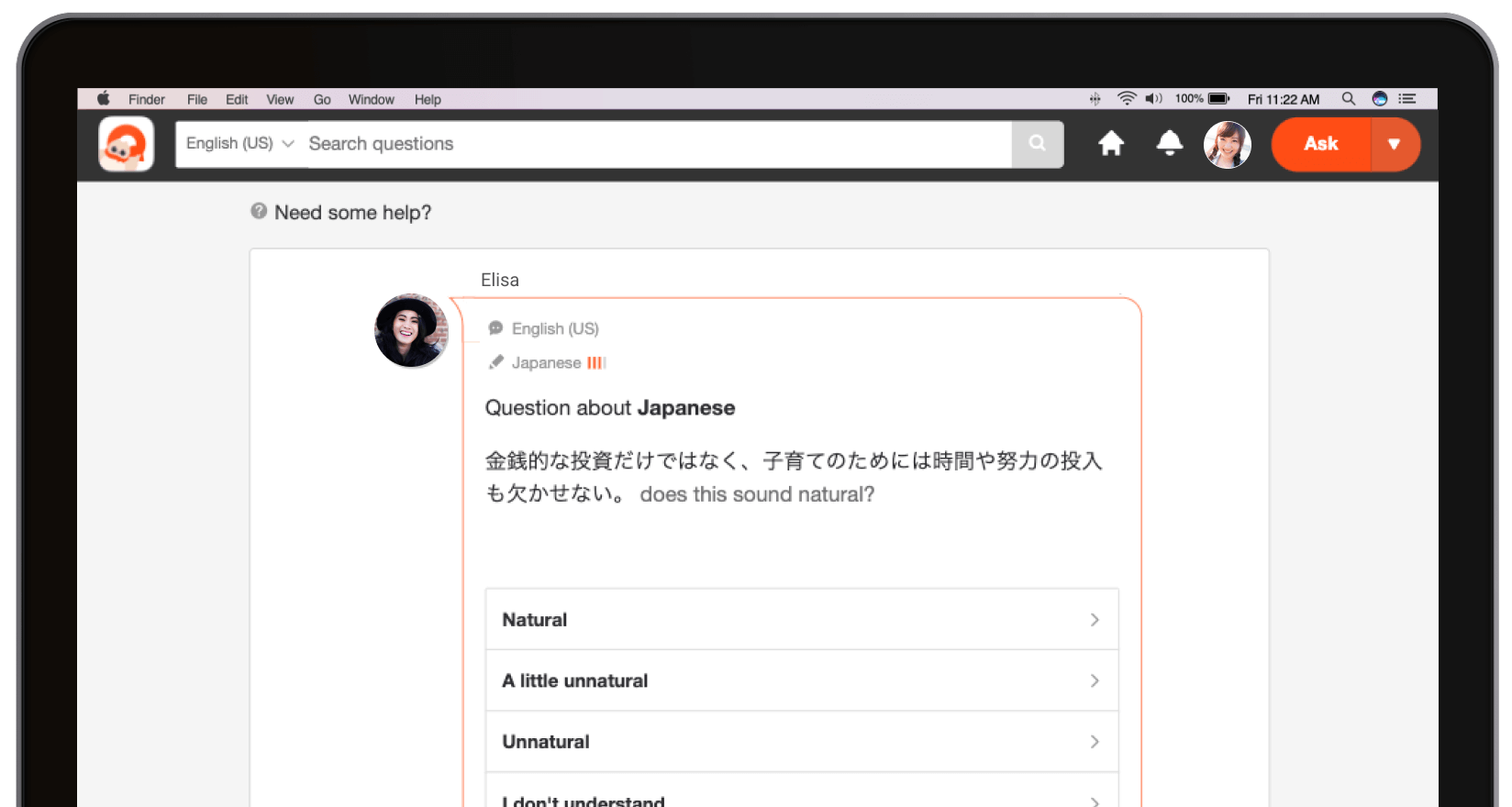Question
Zaktualizowano na
11 wrz 2018
- angielski (amerykański)
-
koreański
-
francuski (Francja)
Pytanie o koreański
Napisz przykładowe zdania z 이/가 and 는/은. I know that sometimes the topic is the same as the subject. In this case would you use the topic marking particle or the subject marking particle? . Postaraj się o przykłady zdań z życia codziennego.
Napisz przykładowe zdania z 이/가 and 는/은. I know that sometimes the topic is the same as the subject. In this case would you use the topic marking particle or the subject marking particle? . Postaraj się o przykłady zdań z życia codziennego.
Odpowiedzi
Więcej komentarzy

Usunięty użytkownik
@crader1 은/는 is named as a topic marker(in Korean : 주제격조사, topic = 주제), while 이/가 is called subject marker(in Korean : 주격조사).
은 and 이 is used after the character ends with a consonant (E.g. 사람은, 꽃이 )
는 and 가 is used after the character ends with a vowel (E.g. 나는, 비가 )
1. 이/가 vs 은/는 in Korean = ‘a/an’ vs ‘the’ in English
이/가 is used to express new information in a sentence = ‘a/an’
은/는 is used to express something mentioned earlier (or old information) = ‘the’
는/은 and 가/이 both are used for the subject of a sentence but 는/은 introduces a topic or a subject whereas 가/이 identifies a subject.
The topic particle, 는/은 is used in cases when we make a general or factual statement whereas "가/이 is Not".
옛날에 한 남자가 살았어요. 그 남자는 아이들이 두 명 있었어요. Once upon a time, there lived a man. He had 2 sons.
저기 토니 씨가 와요. There’s Tony coming.
작년에 파리에 갔었어요. 파리는 정말 아름다웠어요. I went to Paris last year. Paris was really beautiful.
지난 주에 일본어 시험이 있었어요. 이 시험은 너무 어려웠어요 Last week, I have a Japanese language test. That test was very difficult.
2. 이/가 is used for general/specific statement and 은/는 is used for contrast or comparing.
마크 씨는 왔는데, 앤디 씨는 안 왔어. Mark came, but Andy didn't come.
저는 축구는 좋아해요. 그렇지만 야구는 좋아하지 않아요. I like soccer. However I don't care for baseball.
서울에는 눈이 왔어요. 그렇지만 부산에는 눈이 오지 않았어요. Snow fell in Seoul. However, it didn't fall in Busan.
사람들은 많았는데, 제가 찾던 사람은 없었어요. There were many people, but the person I wanted to find wasn't there.
제가 is more stronger than 저는.
if it focuses on the subject.
사람들이 많았는데, 철수는 없었어요. There were many people, but it was not important that is crowded.
철수는 없었어요. it just imply the facts that 철수 is not there.
Auxiliary verbs in English is about the verbs like can, will, should, might. They are used to add meaning to the main verb. There are auxiliary markers(보조사) in Korean and 은/는 are one of them.
As they are auxiliary markers, you can use them with other markers or at the end of a verb conjugation, too.
사람들이 많았는데, 그렇게 혼잡하지는 않았어요. There were many people, but it was not that crowded.
In 혼잡하지는, 는 is used to emphasize the meaning, it was not crowded. Therefore, you can just get rid of it, but the meaning, crowded becomes weaker.
이/가 is stronger than 은/는. 이가 makes the subject stronger.
마크 씨가 왔다. 다들 준비해. Mark came. Get ready, everyone.
아기가 예뻐요. The baby is pretty.
3. 이/가 focuses on subject and 은/는 focuses on description
A: 누가 심부름하러 갔어요?
B: 철수가 갔어요.
A: Who went for the errand?
B: 철수 did.
A: 철수는 지금 뭐해요?
B: 철수는 지금 심부름하러 갔어요.
A: What is 철수 doing now?
B: 철수 went for errand.
In the first conversation, A was curious about the person who went for the errand. So, the focus of the answer is the subject. That's why 가 is used twice like 누가 or 철수가.
In the second conversation, A was curious about what 철수 is doing now. So, the focus of the answer is the action. That's why topic marker 는 is used like 철수는.
In Korean, something trivial or redundant is just deleted, so it becomes clear what is the focus of the question if the answers by B are shortened.
A: 누가 심부름하러 갔어요?
B: 철수요.
A: 철수는 지금 뭐해요?
B: 심부름이요.
4. 이/가 can be used for showing subject and 은/는 is used for showing emphasis or introducing a noun (mostly for person).
안녕하세요. 저는 안나예요. Hello, I am Anna.
우리 한국어 선생님은 남자예요. My Korean teacher is a male.
한국에는 여름에 날씨가 더워요? In Korean, Is it hot in summer? (Emphasizing in Korean)
여기부터는 내가 할게요. From now on, I will do it. (Emphasizing from now on)
지금부터가 진짜 시작해요. From now is the real beginning.
고향이 어디예요? - 제주도가 제 고향이에요. Where is you hometown? -Jeju island is my hometown.
5. When the sentences are combined, 이/가 must be used in the sentence in the middle.
If you make the long sentence by combining several sentences, then the sentence used in the middle(it is called 안긴 문장 in Korean) should only use 이/가.
It is really hard for you to understand what I am saying now, so let's learn with example.
영희는 철수의 말을 조용히 듣고 있었다. 철수는 영희가 집에 빨리 들어가기를 바라는 것 같았다.
영희 was listening to what 철수 was saying quietly. It seems that 철수 wanted 영희 to go back home early.
If we follow the first rule, we should change 영희가 in the second sentence to be 영희는. Because that's the second time 영희 is mentioned. But the second sentence is combined sentence. It is a combination of 철수는 --를 바라는 것 같았다 and 영희가 집에 빨리 들어가다. As 영희가 집에 빨리 들어가다 is in the middle of 철수는 --를 바라는 것 같다, 영희가 is used.
But it was really long topic. As it is long, it might take some time to get used to it.
Czy ta odpowiedź była pomocna?
[Aktualności] Hej, Ty! Ty uczący się języka!
Wiesz jak poprawić swój język obcy❓ Potrzebujesz tylko, żeby Twoje teksty poprawił native speaker!
W HiNative native speaker poprawi Twoje teksty za darmo ✍️✨.
W HiNative native speaker poprawi Twoje teksty za darmo ✍️✨.
Zarejestruj się
Related questions
Trending questions
- Napisz przykładowe zdania z 누워서 떡 먹기.
- Napisz przykładowe zdania z used 키가 크다 in a sentence.
- Napisz przykładowe zdania z 착각하다, 실례가 되다.
- Napisz przykładowe zdania z -을래 / -밖에 Explanation for those rules with examples please!! ☺️☺️.
- Napisz przykładowe zdania z 느끼다.
Newest Questions (HOT)
Newest Questions
Poprzednie pytanie / Następne pytanie

Dziękujemy! Zapewniamy Cię, że Twoja opinia nie będzie widoczna dla innych użytkowników.
 Dziękujemy! Twoja opinia jest dla nas bardzo cenna.
Dziękujemy! Twoja opinia jest dla nas bardzo cenna.






